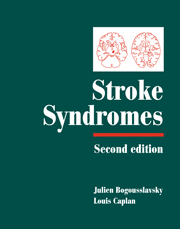Book contents
- Frontmatter
- Contents
- List of contributors
- Preface
- PART I CLINICAL MANIFESTATIONS
- PART II VASCULAR TOPOGRAPHIC SYNDROMES
- 29 Arterial territories of human brain
- 30 Superficial middle cerebral artery syndromes
- 31 Lenticulostriate arteries
- 32 Anterior cerebral artery
- 33 Anterior choroidal artery territory infarcts
- 34 Thalamic infarcts and hemorrhages
- 35 Caudate infarcts and hemorrhages
- 36 Posterior cerebral artery
- 37 Large and panhemispheric infarcts
- 38 Multiple, multilevel and bihemispheric infarcts
- 39 Midbrain infarcts
- 40 Pontine infarcts and hemorrhages
- 41 Medullary infarcts and hemorrhages
- 42 Cerebellar stroke syndromes
- 43 Extended infarcts in the posterior circulation (brainstem/cerebellum)
- 44 Border zone infarcts
- 45 Classical lacunar syndromes
- 46 Putaminal hemorrhages
- 47 Lobar hemorrhages
- 48 Intraventricular hemorrhages
- 49 Subarachnoid hemorrhage syndromes
- 50 Brain venous thrombosis syndromes
- 51 Carotid occlusion syndromes
- 52 Cervical artery dissection syndromes
- 53 Syndromes related to large artery thromboembolism within the vertebrobasilar system
- 54 Spinal stroke syndromes
- Index
- Plate section
32 - Anterior cerebral artery
from PART II - VASCULAR TOPOGRAPHIC SYNDROMES
Published online by Cambridge University Press: 17 May 2010
- Frontmatter
- Contents
- List of contributors
- Preface
- PART I CLINICAL MANIFESTATIONS
- PART II VASCULAR TOPOGRAPHIC SYNDROMES
- 29 Arterial territories of human brain
- 30 Superficial middle cerebral artery syndromes
- 31 Lenticulostriate arteries
- 32 Anterior cerebral artery
- 33 Anterior choroidal artery territory infarcts
- 34 Thalamic infarcts and hemorrhages
- 35 Caudate infarcts and hemorrhages
- 36 Posterior cerebral artery
- 37 Large and panhemispheric infarcts
- 38 Multiple, multilevel and bihemispheric infarcts
- 39 Midbrain infarcts
- 40 Pontine infarcts and hemorrhages
- 41 Medullary infarcts and hemorrhages
- 42 Cerebellar stroke syndromes
- 43 Extended infarcts in the posterior circulation (brainstem/cerebellum)
- 44 Border zone infarcts
- 45 Classical lacunar syndromes
- 46 Putaminal hemorrhages
- 47 Lobar hemorrhages
- 48 Intraventricular hemorrhages
- 49 Subarachnoid hemorrhage syndromes
- 50 Brain venous thrombosis syndromes
- 51 Carotid occlusion syndromes
- 52 Cervical artery dissection syndromes
- 53 Syndromes related to large artery thromboembolism within the vertebrobasilar system
- 54 Spinal stroke syndromes
- Index
- Plate section
Summary
Anatomy
The anterior cerebral artery (ACA) arises as the medial branch of the bifurcation of the internal carotid artery (ICA) at the level of the anterior clinoid process. The ACA supplies the whole of the medial surfaces of the frontal and parietal lobes, the anterior four-fifths of the corpus callosum, the frontobasal cerebral cortex, the anterior diencephalon, and other deep structures. The posterior extent of the ACA depends on the extent of the supply of the posterior cerebral artery and its splenial branches. The band of lateral cortex supplied by the ACA is wider anteriorly, often extending beyond the superior frontal sulcus, and is narrowed progressively posteriorly. The ACA can be divided into five segments (A1–A5) (Fischer, 1938). The A1 segment, also called the proximal ACA, is the part between the internal carotid bifurcation and the anterior communicating artery (ACoA). The postcommunicating part of the ACA comprises the segments A2, A3, A4, and A5, which are generally designated the distal ACA. The A2 and A3 segments together are referred to as the ascending segment, with inferior forward convexity (A2) and superior forward convexity (A3). The A4 and A5 segments form the horizontal segment, extending posteriorly to the coronal suture (A4) and from there to the artery's termination.
Basal arteries and their perforating branches
Many perforating branches arise from the anterior circle of Willis (Table 32.1, Fig. 32.1). Most of them are thin, and only the recurrent artery of Heubner can be easily identified by means of angiography. As with other penetrating arteries supplying the diencephalon and basal ganglia, those originating from the ACA and ACoA have sparse anastomoses (‘end-zone arteries’).
- Type
- Chapter
- Information
- Stroke Syndromes , pp. 439 - 450Publisher: Cambridge University PressPrint publication year: 2001
- 4
- Cited by



